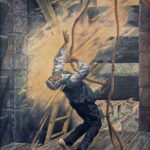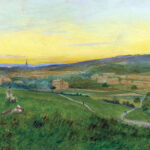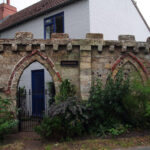10 June 1715: Following the accession of the Hanoverian George I, Tories ring the bells of Leeds church on the birthday of his Jacobite rival, the Old Pretender, currently plotting a comeback
Flying Post or the Post Master. 1716/01/14. The Information of Thomas Hutchinson of Leeds in the County of York, Yeoman, taken upon Oath the 21st Day of June. Anno. Dom. 1715. Flying Post or the Post Master. Ed. C. Ridley. London. Reproduction by kind permission of Central Council of Church Bell Ringers. Get it:
.Excerpt
Thomas Hutchinson of Leeds, yeoman, says that upon Friday the 10th day of this instant June, being the Pretender’s birthday, betwixt nine and ten at night, he went into the great churchyard of Leeds, the bells of the church being then a-ringing, and had been ringing a considerable time, where he saw a great number of people, and asking some of the mob what was the meaning of the ringing of the bells, he was answered by one of the mob, who said he as one of the ringers, that they were ringing for the king’s son, it being his birthday, after which he went home. Going again to the same place a second time, and asking the meaning of the ringing the bells a second time, where the mob were still in the churchyard, told one of the men, who said he was one of the ringers, he would give him a pint of ale if he would tell him what the bells were ring for. The person replied that though Mr John Dodgson had been to discharge them from ringing (the person who told him so having then put on his waistcoat), they were ringing for the Pretender, and they would go and ring again on purpose to grieve some persons, the bells continuing until 12 that night. When this informant came back again, he saw a bonfire in the great street in Leeds called Briggate, on Mr Ormroyde’s front, and a great many persons about it, which continued for some time, and the persons about it fired and threw several squibs or rockets made of gunpowder.
Comment
Comment
In various records which have come down to us, bearing date about the times of the Reformation, reference is often made to, and sufficient evidence is given of, the superstitious usage of Church Bells: and there is, too, room for but little doubt that they, as well as the Church itself, were in those later ages frequently applied to profane purposes.
Again, the Rules and doggrel verses (generally from one to two hundred years old) which remain in many of our Belfries, while they often show that the Bells were still used for holy purposes, and according to their original design, afford alas! a melancholy evidence that the Ringing of them was no longer esteemed a sacred service.
Toward the latter half of the last century (that worst age of the English Church) the Ringing of the Church Bells became a fashionable amusement among the Yeomanry and Gentry, and was degraded to the level on which the hurdle-race and steeple-chase now stand; and while their sweet voices were seldom heard for any holy purpose, they were made continually to wake the echoes of the neighbourhood, in no more noble cause, for no more sacred object, than the battue-shooting of the present day.
This amusement, however, at any rate in most parts of the country, has long ago “become vulgar” and “gone out of fashion”: till at last our Belfries – though dedicated to God’s service – are left in a state of filthy dilapidation, receptacles for dirt and rubbish of all kinds, and very frequently the drinking-place of the most profane and profligate persons in the parish; who – totally ignorant of the sacred character, and Heavenly uses, of those holy instruments they are desecrating – ring the Bells for their amusement, amid oaths and obscenity, and sell their voices, for drink-money, for any worldly purpose – who ring “the muffled” or “the merry peal” for the rich man’s sorrow or rejoicing, but never send forth a sound of unbought sympathy with the poor.
Was the silence of York Minster’s bells ca 1715-29 related to the first Jacobite rising? It wasn’t just the Minster – St Martin’s only had one bell left in 1729, when five were added.
Something to say? Get in touch
Original
The Information of Thomas Hutchinson of Leeds in the County of York, Yeoman, taken upon Oath the 21st Day of June. Anno; Dom. 1715.
Who saith, That upon Friday the 10th Day of this Instant June, being the Pretender’s BirthDay, betwixt nine and ten at Night, he this Informant, went into the great Churchyard of Leeds aforesaid, the Bells of the said Church being then a ringing, and had been ringing a considerable time, where he saw a great Number of People, and asking some of the Mob, What was the Menaning[sic] of the Ringing of the said Bells? he was answer’d by one of the Mob, who said he as one of the Ringers, That they were ringing for the King’s Son, it being his Birth-Day, after which he went home; and going gain to the same Place a second Time, and asking the meaning of the ringing the Bells a second Time, where the said Mob were still in the said Churchyard, told one of the Men, who said he was one of the Ringers, he would give him a Pint of Ale, if he would tell him what the Bells were ring for, the said Person reply’d, That tho’ Mr. John Dodgson had been to discharge them from ringing, (the Person who told him so having then put on his waistcoat) they were ringing for the Pretender, and they would go and ring again on purpose to grieve some Persons, the said bells continuing until 12 that Night, and further saith thatwhen this Informant came back again, he saw a Bonfire in the great Street in Leeds, call’d Briggate, on Mr. Ormroyde’s Front, and a great many Persons about it, which continued for some time, and the Persons about it fir’d and threw several Squibs or Rockets made of Gunpowder.
331 words.
Similar
 17 November 1812: A doggerel inscription at St. George’s, Doncaster, commemorates two sons of ringing master Robert Smith, one of whom died by his father’s bells
17 November 1812: A doggerel inscription at St. George’s, Doncaster, commemorates two sons of ringing master Robert Smith, one of whom died by his father’s bells 30 May 1835: Alfred Austin, future poet laureate, “Banjo-Byron that twangs the strum-strum,” is born into rural splendour at Ashwood, 48 Headingley Lane, Leeds
30 May 1835: Alfred Austin, future poet laureate, “Banjo-Byron that twangs the strum-strum,” is born into rural splendour at Ashwood, 48 Headingley Lane, LeedsSearch
Donate
Music & books
Place-People-Play: Childcare (and the Kazookestra) on the Headingley/Weetwood borders next to Meanwood Park.
Music from and about Yorkshire by Leeds's Singing Organ-Grinder.



 Bluesky
Bluesky Extwitter
Extwitter